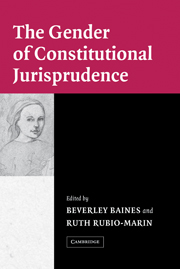Book contents
- Frontmatter
- Contents
- List of Contributors
- Acknowledgments
- The Gender of Constitutional Jurisprudence
- Introduction: Toward a Feminist Constitutional Agenda
- 1 Speaking into a Silence: Embedded Constitutionalism, the Australian Constitution, and the Rights of Women
- 2 Using the Canadian Charter of Rights and Freedoms to Constitute Women
- 3 Emancipatory Equality: Gender Jurisprudence under the Colombian Constitution
- 4 Gender Equality and International Human Rights in Costa Rican Constitutional Jurisprudence
- 5 Constituting Women: The French Ways
- 6 Gender in the German Constitution
- 7 India, Sex Equality, and Constitutional Law
- 8 Constitutional Transformation, Gender Equality, and Religious/National Conflict in Israel: Tentative Progress through the Obstacle Course
- 9 “No Nation Can Be Free When One Half of It Is Enslaved”: Constitutional Equality for Women in South Africa
- 10 Engendering the Constitution: The Spanish Experience
- 11 Gender Equality from a Constitutional Perspective: The Case of Turkey
- 12 Gender and the United States Constitution: Equal Protection, Privacy, and Federalism
- Index
- References
2 - Using the Canadian Charter of Rights and Freedoms to Constitute Women
Published online by Cambridge University Press: 14 January 2010
- Frontmatter
- Contents
- List of Contributors
- Acknowledgments
- The Gender of Constitutional Jurisprudence
- Introduction: Toward a Feminist Constitutional Agenda
- 1 Speaking into a Silence: Embedded Constitutionalism, the Australian Constitution, and the Rights of Women
- 2 Using the Canadian Charter of Rights and Freedoms to Constitute Women
- 3 Emancipatory Equality: Gender Jurisprudence under the Colombian Constitution
- 4 Gender Equality and International Human Rights in Costa Rican Constitutional Jurisprudence
- 5 Constituting Women: The French Ways
- 6 Gender in the German Constitution
- 7 India, Sex Equality, and Constitutional Law
- 8 Constitutional Transformation, Gender Equality, and Religious/National Conflict in Israel: Tentative Progress through the Obstacle Course
- 9 “No Nation Can Be Free When One Half of It Is Enslaved”: Constitutional Equality for Women in South Africa
- 10 Engendering the Constitution: The Spanish Experience
- 11 Gender Equality from a Constitutional Perspective: The Case of Turkey
- 12 Gender and the United States Constitution: Equal Protection, Privacy, and Federalism
- Index
- References
Summary
In 1867, Britain gave its Canadian colonies a written Constitution that imposed a federal system of parliamentary government. While making jurisdiction a constraint on law-making, this Constitution did not provide Canadians with human rights protections (although rights such as freedom of contract and private property received common law protection). The legislatures could pass laws denying women the right to vote, hold public office, serve on juries or in the armed forces, immigrate, perform certain jobs, have an independent domicile or continue to work after marriage, dispose of property, have an abortion, receive unemployment insurance after giving birth, retain aboriginal status on marrying a non-aboriginal, or retain Canadian citizenship on marrying a non-Canadian. Whenever litigants challenged these laws by invoking international, statutory, or unwritten human rights protections, most Canadian judges refused to recognize their claims. Thus, constitutional litigation was not a viable strategy for women.
This picture changed significantly when the existing Constitution was supplemented by new constitutional provisions in 1982. Prominent among these changes was the Charter, which delineates seven major rights: political (religion, expression, assembly, and association), democratic, mobility, legal, equality, language (official and minority educational), and aboriginal rights. Canadians may assert Charter rights against both levels of government, albeit not against private actors unless they are carrying out a governmental function. This rights protection regime transformed the system of government from parliamentary to constitutional supremacy by assigning the enforcement of Charter rights to the regular courts.
- Type
- Chapter
- Information
- The Gender of Constitutional Jurisprudence , pp. 48 - 74Publisher: Cambridge University PressPrint publication year: 2004
References
- 2
- Cited by

